Nēnē Gosling Found Dead At Liliʻuokalani Park
By Jordan Lerma
Published: April 22, 2024
Last Updated: November 19, 2024
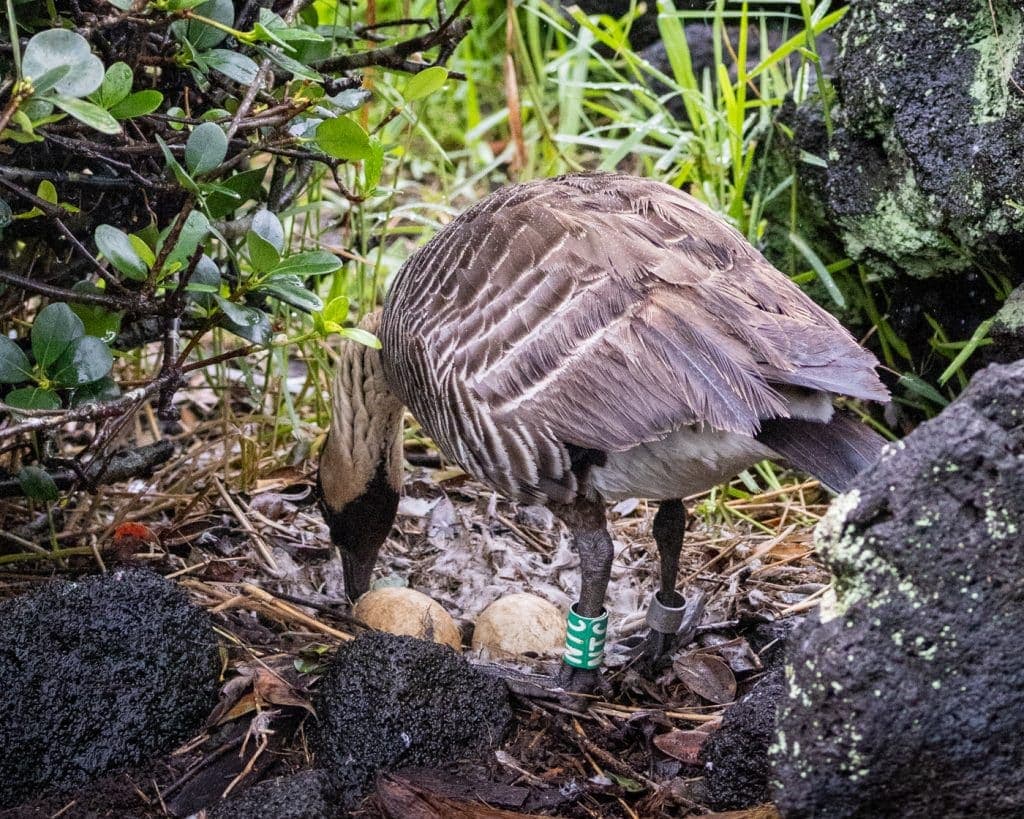
Help Protect Hawaiian Wildlife
Join us in our mission to protect endangered Hawaiian species from toxoplasmosis
Sign our PetitionOverview
The year 2024 has been marked by a series of devastating events centered around NTC, a well-documented Nēnē at Liliʻuokalani Park and Gardens, and her nesting attempts. These events have highlighted the numerous threats facing Nēnē in urban environments, particularly the impacts of feral cat colonies, unmanaged pets, and human activities.
In October, NTC's mate, 595, was tragically killed in a hit-and-run incident near the park, leaving NTC to face the nesting season alone. Despite this loss, NTC showed remarkable resilience, laying three eggs in mid-November. The community rallied around her, providing daily updates to help monitor the nest and support her efforts to raise a new generation.
Tragically, the nest was subject to multiple incidents. On November 30, a leashed dog trampled the nest, cracking one egg. The remaining egg continued to be closely watched, and on the night of December 21 or early morning of December 22, the egg likely hatched based on the behavior of NTC and the shell remains in the nest. However, the gosling was not found the morning of December 22. The absence of a carcass made it difficult to determine the cause of death, but based on the nest's proximity to a large feral cat colony, the loss has been attributed to probable predation. The colony, which is fed twice daily by various individuals, including consistent morning feedings at 7 a.m. by Doreen Torres, has been documented to attract non-target species such as mongoose, further increasing risks to wildlife in the area.
These incidents follow a pattern of vulnerability for NTC and her offspring. Earlier in the year, a gosling was lost to toxoplasmosis, a disease linked to feral cat colonies. NTC herself has been at the center of prior incidents, including one in March 2023 when a gosling of hers was taken by Meiqin Chen and placed in an onion bag.
These ongoing challenges underscore the need for greater protections for Nēnē in urban environments. Unmanaged feeding practices and the presence of feral cat colonies not only endanger Nēnē but also create unsanitary and hazardous conditions for both wildlife and the community.
We are deeply grateful for the efforts of community members and park goers who continue to monitor and document these events, providing invaluable data to guide conservation efforts and shape new policy and regulations.
Photo Documentation
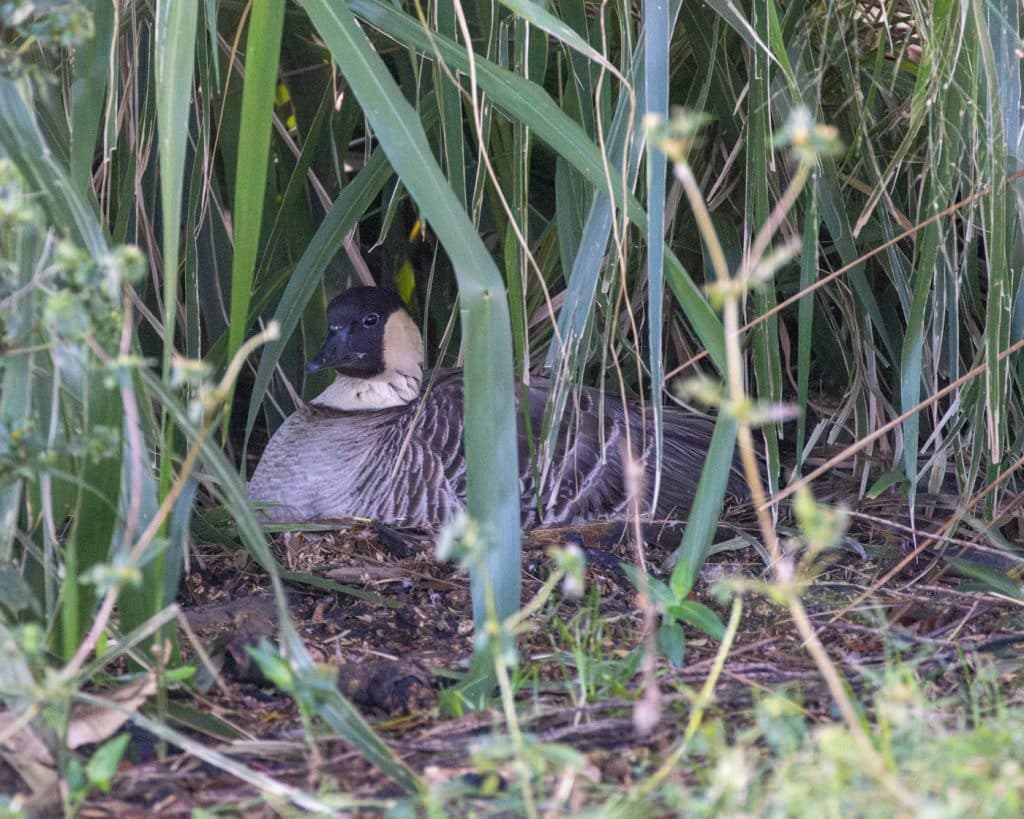
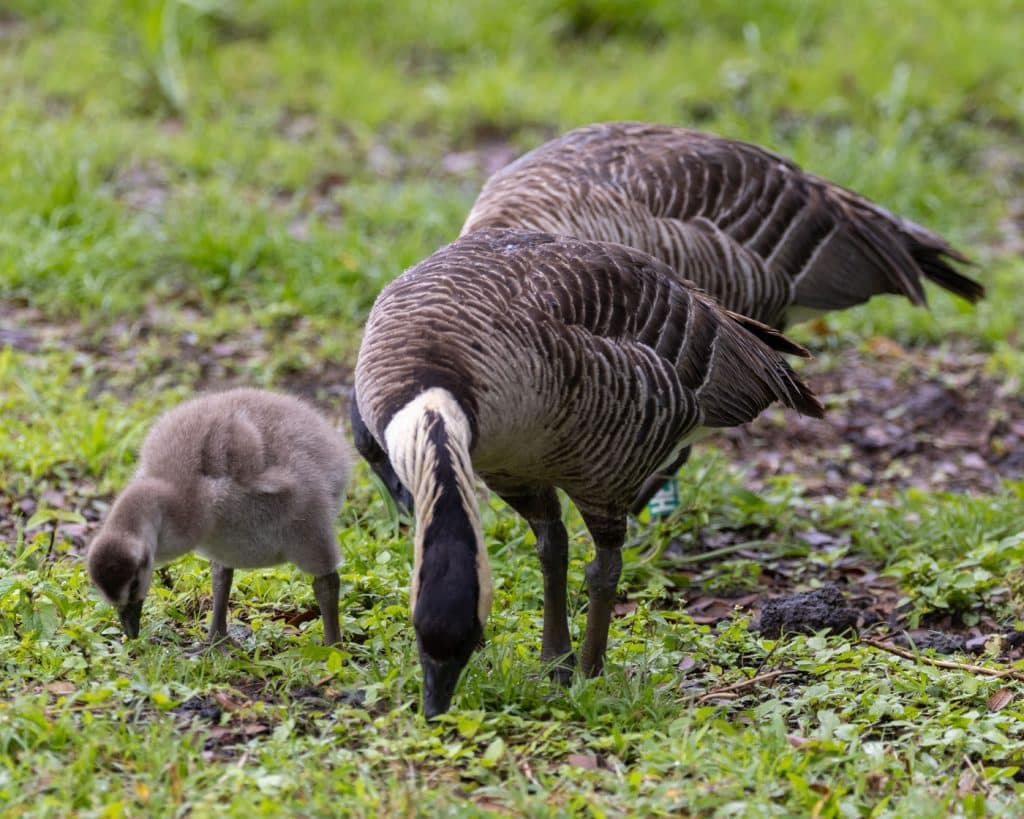
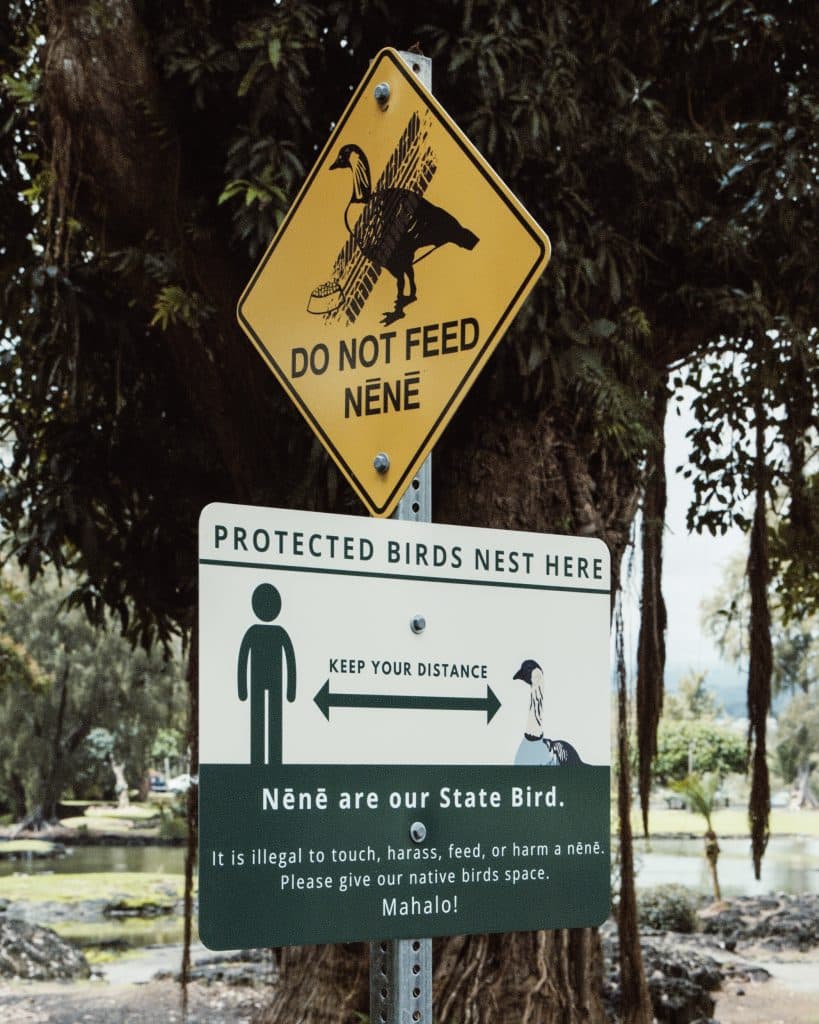
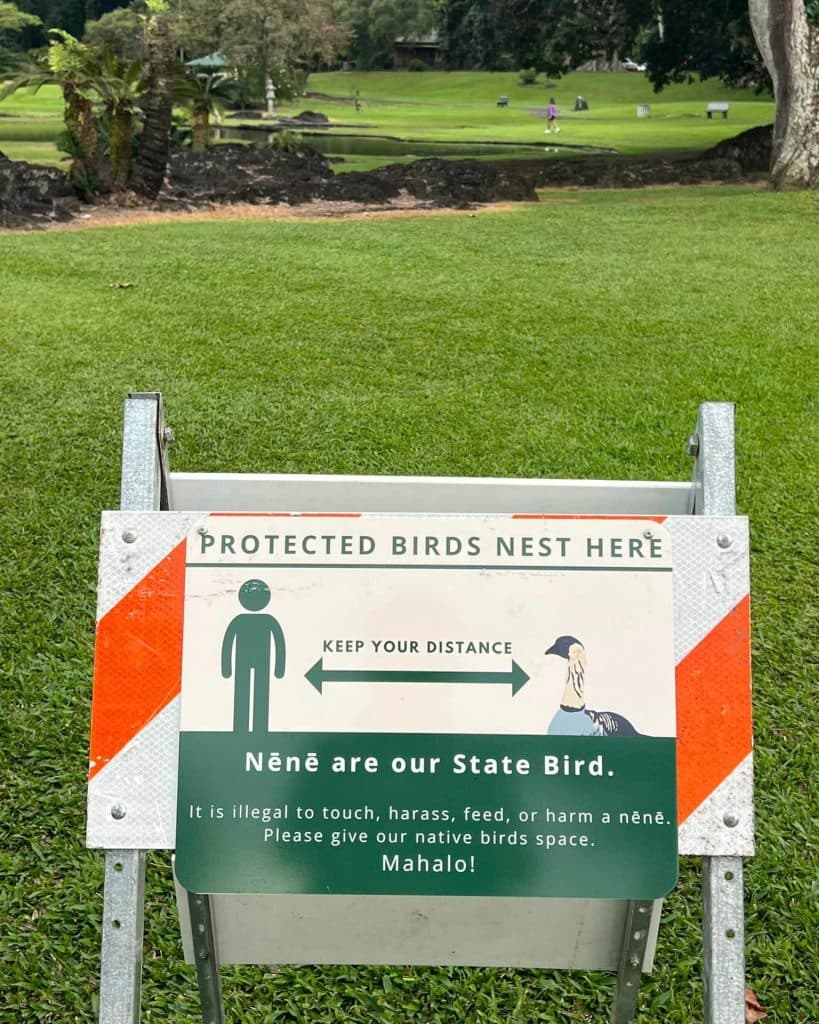
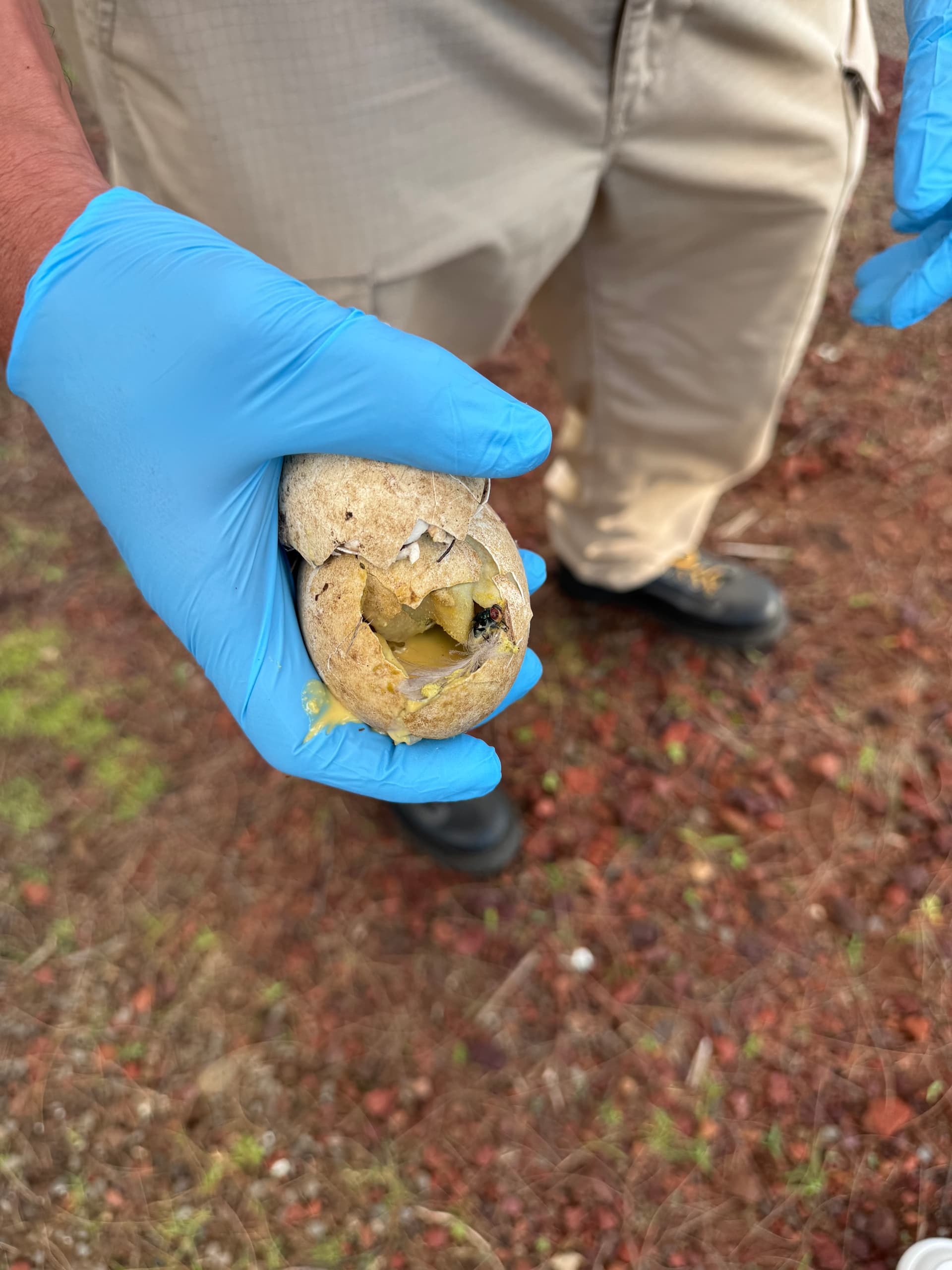
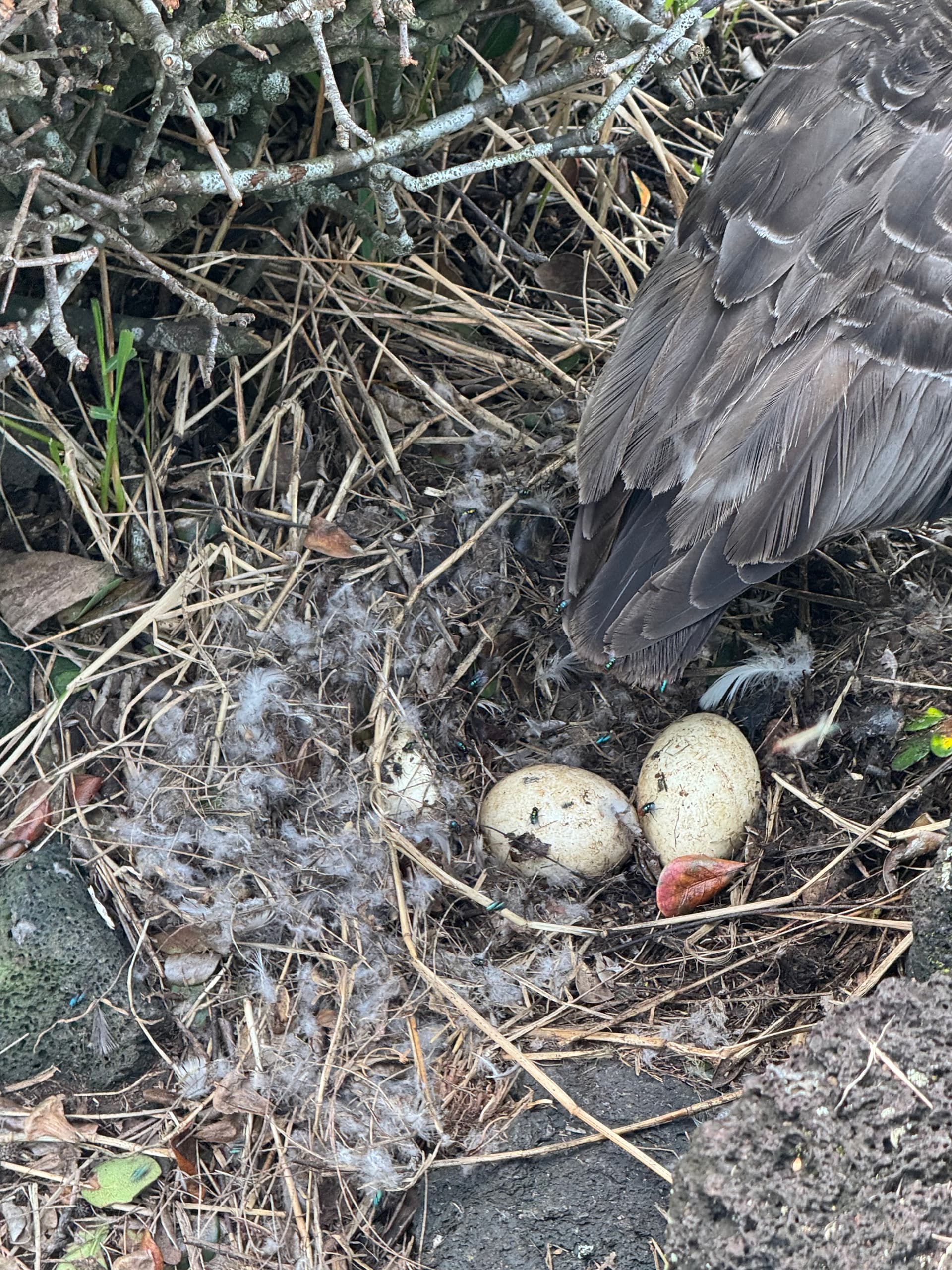
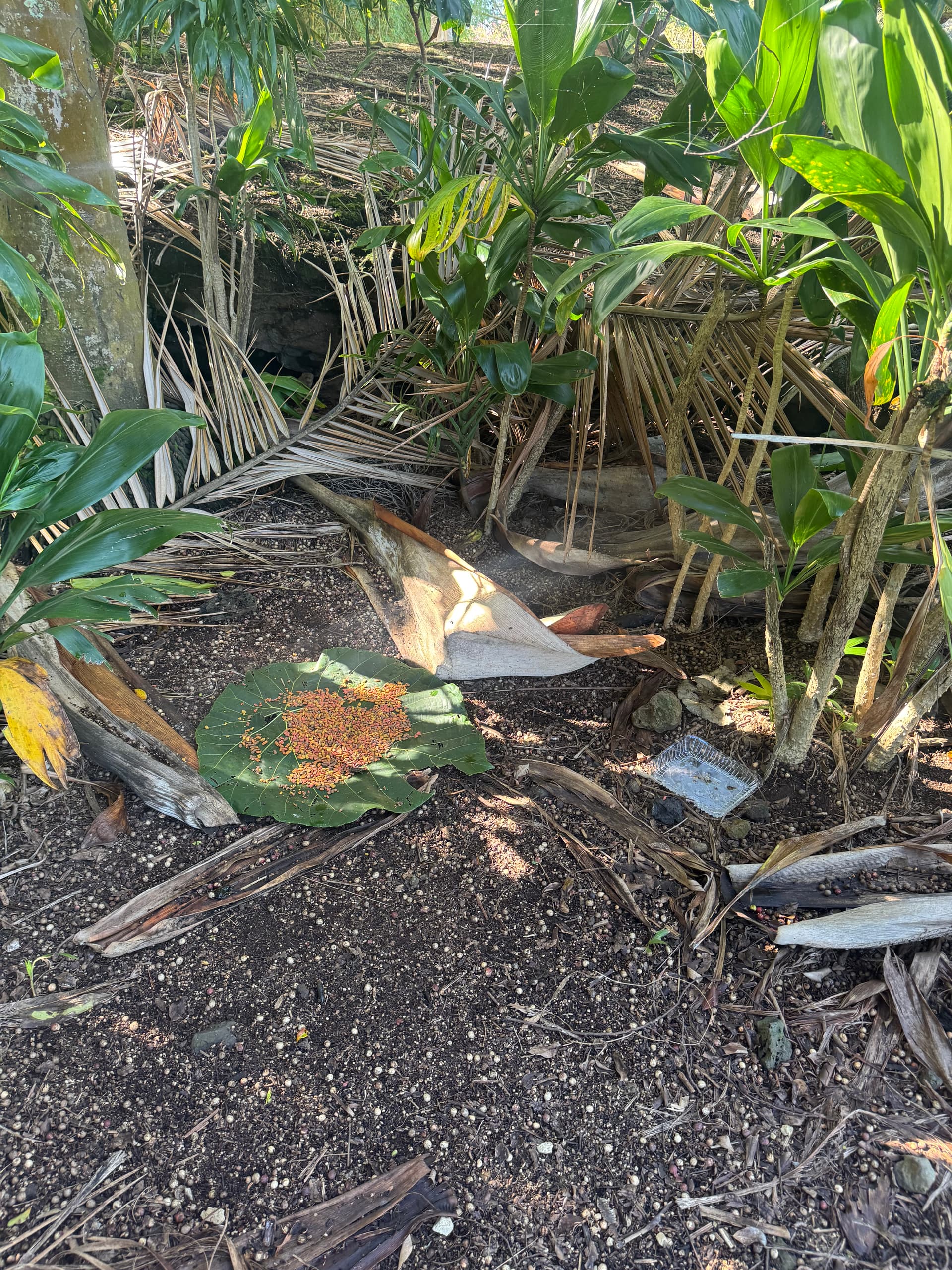
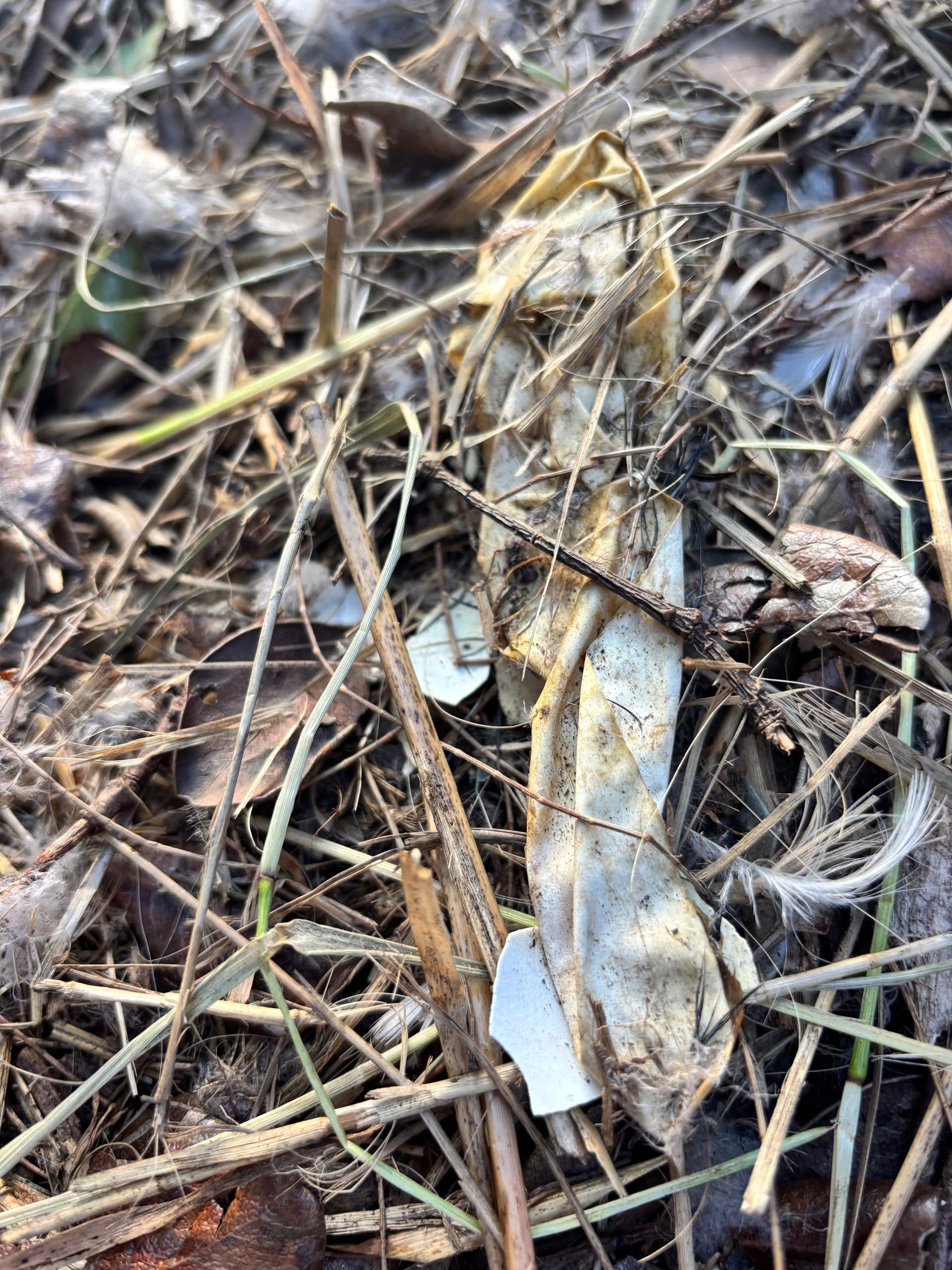
This is a story of multiple tragedies affecting a nēnē family at Liliʻuokalani Park and Gardens. In March 2024, NTC and 595's gosling died from toxoplasmosis, a disease carried by feral cats. Seven months later, in October 2024, 595 was killed in a hit-and-run incident near a cat feeding station. Most recently, in December 2024, after NTC laid new eggs, one was damaged by a leashed dog, and a newly hatched gosling disappeared, likely due to predation.
Background
NTC and 595 were among the most frequently documented nēnē in our dataset, with a history of nesting attempts at Liliʻuokalani Park and Gardens. Their story gained public attention in March 2023 when one of their goslings was taken by Meiqin Chen and placed in an onion bag. Despite this incident, the pair continued to return to the park, demonstrating the strong site fidelity characteristic of nēnē pairs.
First Tragedy: March 2024 Gosling Loss
On February 8th, 2024, we documented the hatching of a gosling to NTC and 595. Over 20 community members helped monitor this nēnē family, reporting concerning interactions including people approaching too closely, children chasing the gosling, and the presence of off-leash dogs, cats, and mongooses. The family was also observed consuming cat food left in the area.
Despite increased signage by the Hawaiʻi Department of Land and Natural Resources (DLNR), the gosling was found dead on March 5, 2024. A necropsy by the USGS National Wildlife Health Center confirmed toxoplasmosis as the cause of death - a disease for which cats are the only definitive hosts in Hawaiʻi.
Second Tragedy: Loss of 595
On October 10, 2024, 595 was fatally struck by a vehicle near the Hilo Hawaiian Hotel side of the park. In the weeks leading up to this incident, 595 and NTC had been documented crossing this area in the mornings around 7 a.m., coinciding with scheduled cat feeding times. The pair had been observed copulating just days before 595's death, indicating preparation for the upcoming nesting season.
Third Tragedy: December 2024 Nest Incidents
Following 595's death, NTC demonstrated remarkable resilience by laying three eggs in mid-November. However, on November 30, a leashed dog trampled the nest while its owners stood by, resulting in one cracked egg. The community continued to monitor the remaining egg closely. Based on NTC's behavior and shell remains found in the nest, the egg likely hatched during the night of December 21 or early morning of December 22. Tragically, no gosling was found on the morning of December 22, and the absence of a carcass has made it difficult to determine the exact cause of death. Given the nest's proximity to a large feral cat colony, predation is considered the most likely explanation.
These incidents illustrate the complex challenges facing urban nēnē populations. The presence of feral cat colonies and their feeding stations creates multiple threats: disease transmission through toxoplasmosis, attraction of predators like mongoose, and the drawing of nēnē into dangerous urban areas. Additionally, insufficient pet control and direct human interference continue to impact nesting success. The situation is further complicated by unmanaged feeding practices, with food left unattended attracting both target and non-target species, creating additional risks for native wildlife.
Case Updates
Defense Requests Extension
Doreen M. Torres' legal team, led by attorney Eric R. Overton, submitted a stipulated judgment to extend the deadline for pretrial motions. The defense cited the receipt of discovery materials on December 23, 2024, after the original statutory deadline of December 6, 2024. Additional time is required to review the materials, consult with a potential witness, and complete the investigation. The prosecution, represented by Deputy Prosecuting Attorney Woodrow Pengelly, did not oppose the extension request. A potential plea agreement is under discussion (View Document), with further input from the court expected at the February 19, 2025, hearing.
NTC's Gosling Lost Shortly After Hatching
On the morning of December 22, DLNR observed NTC exhibiting distressed behavior typical when nēnē lose a member of their social group. Investigation of the nest revealed only egg shells, indicating a successful hatch had occurred. The last confirmed sighting of NTC sitting on one egg was at 6 p.m. on December 21. Based on photo and video analysis from community members and DLNR, it's believed the egg hatched during the night of December 21 or early morning of December 22.
No gosling or carcass was found, making it impossible to definitively determine the cause of death. The nest's location near a large feral cat colony suggests probable predation, though without direct evidence, the predator could have been a cat, mongoose, or dog.
The incident has brought attention to the feral cat colony near the nest, which receives twice-daily feedings. Morning feedings at 7 a.m. are conducted by Doreen Torres, who leaves food unattended, allowing consumption by non-target species including mongoose and nēnē. This practice differs from other feeders who monitor food distribution and clean up afterward. The situation has led to unsanitary conditions, with cats defecating in spaces shared by the community and nēnē.
Throughout December, community members and park visitors provided valuable daily updates about NTC's nest, demonstrating the crucial role of community monitoring in tracking Hawaiʻi's dispersed nēnē population. This tragic loss emphasizes the urgent need to address feral cat colonies in sensitive wildlife areas to protect endangered nēnē from predation and other environmental threats.
Nēnē Nest Destroyed by Leashed Dog
At Liliʻuokalani Park and Gardens in Hilo, a leashed dog trampled a nēnē nest, resulting in cracked eggs. The damage was discovered on December 1, following the incident which occurred on November 30. Witnesses reported that two adults accompanying the dog stood by and did not intervene as the endangered state bird's nest was destroyed.
The incident highlights the ongoing threats to Hawaiʻi's nēnē population, particularly in urban areas where human activity disrupts their nesting sites. Authorities remind the public to keep pets away from wildlife habitats and report any incidents that could harm protected species. An investigation into the incident is ongoing.
Release Terms Set
The court granted Doreen M. Torres' release on her own recognizance, with her next court dates set for February 19, 2025 (pretrial conference), and March 19, 2025 (further proceedings). Defense counsel Eric Overton appeared via video conference, and Torres waived her right to a speedy trial under Rule 48.
Motion to Dismiss Denied
The court denied the defendant's motion to dismiss, stating there was no substantial prejudice to the defense. The State's motion to amend the complaint to provide more specific definitions of the charges was approved. Torres was formally arraigned, entered a plea of Not Guilty, and requested a jury trial. The case was committed to Circuit Court, with further proceedings scheduled for November 27, 2024.
NTC Begins Nesting with Three Eggs
In a hopeful turn of events, NTC, the mate of the recently deceased nēnē 595, has laid three eggs and is actively sitting on the nest at Liliʻuokalani Park and Gardens in Hilo. This development offers a poignant continuation of the pair's legacy, coming just weeks after 595's tragic death in a hit-and-run incident.
Conservation officials are maintaining close surveillance of the nest to ensure its protection. The public is reminded to maintain a safe distance from nesting nēnē to prevent any disturbances that could affect the successful hatching of these precious eggs.
Case Proceeds to Circuit Court
The judge denied Doreen M. Torres' motion to dismiss and allowed the case to proceed. The State's motion to amend the complaint was granted, and Torres was arraigned on the amended complaint. She entered a plea of Not Guilty and requested a jury trial. The case was committed to Circuit Court for further proceedings on November 27, 2024.
Complaint Amendment
The prosecution amended the complaint against Doreen M. Torres to provide greater specificity regarding the charges, strengthening the State's case.
Tragic Loss: Nēnē 595 Killed in Hit-and-Run
A male nēnē, identified as 595, was fatally struck by a vehicle in a hit-and-run incident near Liliʻuokalani Park and Gardens in Hilo. The Department of Land and Natural Resources (DLNR) has launched an investigation and is seeking public assistance. Witnesses are urged to contact the DLNR Division of Conservation and Resources Enforcement at 808-933-3460.
This tragic event follows weeks of documented crossings by 595 and his mate, NTC, near the Hilo Hawaiian Hotel side of the park in the mornings. The pair's movements in the area coincided with reports that Doreen Torres regularly feeds feral cats there around 7 a.m., which has created hazardous conditions for nēnē. Adding to the heartbreak, 595 and NTC were observed copulating just days before his death, signaling the potential for a new nesting season.
The DLNR underscores that feeding feral cats not only disrupts natural wildlife behaviors but also increases the likelihood of nēnē being drawn into dangerous urban settings. This is the second death involving 595 this year, as his gosling previously succumbed to toxoplasmosis in April. Officials are urging the community to take responsible actions to protect Hawaiʻi's endangered state bird and prevent further tragedies.
Restorative Justice Negotiations
During a court hearing, defense negotiations regarding restorative justice continued. Torres waived her right to a speedy trial, and the court scheduled her arraignment and plea hearing for November 15, 2024.
Nēnē Gosling Dies from Toxoplasmosis
A community member reported hearing adult nēnē vocalizing and discovered the gosling deceased at Liliʻuokalani Park and Gardens. DOFAW biologist Raymond McGuire responded to collect the gosling for examination. A necropsy conducted by the USGS National Wildlife Health Center confirmed toxoplasmosis as the cause of death.
The death occurred despite efforts by the Hawaiʻi Department of Land and Natural Resources (DLNR) to increase park signage warning about wildlife interactions. The gosling had been monitored by over 20 community members since its hatching on February 8th, with reports noting concerning interactions including people approaching too closely, children chasing the gosling, and instances of the nēnē family consuming cat food.
This tragic loss highlighted the dangers of toxoplasmosis, a disease for which cats are the only definitive hosts in Hawaiʻi. The presence of feral cats and their feeding stations in the park created conditions that ultimately proved fatal for the young nēnē.